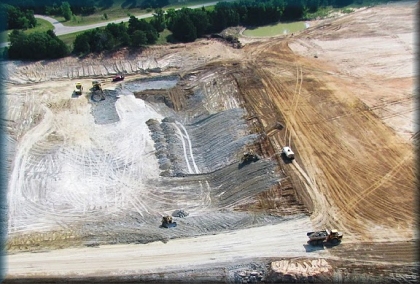 |
 |





 |








 |
    |
Recently, a new dimension in hydraulic fracturing for natural gas and oil has surfaced, and it has the potential for including the very worst of all the major adverse effects of natural gas drilling and production in a single facet of this heavy industrial process. We are talking about frac sand mining.
Frac sand is used as a proppant to hold open the fractured shale formation layers. It is mixed with water and chemicals before being injected into a well bore at about 15-16,000 pounds per square inch (psi) to break open shale layers containing gas or oil. Watch the video on the link below for an understanding of the entire drilling and frac'ing process: Today, most frac'ed wells use a combination of water, sand and chemicals to break open shale layers and release natural gas and oil. But until now nobody has given much thought to how much sand is required and where it originates. This page will provide information to help people understand the nuances of frac sand mining and how they affect air, water and soil quality, human and animal health, environmental sustainability and infrastructure integrity of roads, bridges and highways. The issue will be discussed in relation to each of the various aspects of sand mining operations and how they affect our daily lives. The preferred proppant used in hydraulic fracturing is sand because of its abundance and relatively cheap cost. But, not all sand is equal. Natural gas and oil exploration and production require sand that is round and crushproof under enormous pressure. In the United States there are two preferred types of frac sand - Ottawa (white) and Brady (brown), the former found mostly in the St. Peter sandstone formations spanning north-to-south from Minnesota to Missouri and east-to-west from Illinois into Nebraska and South Dakota. This quartz silica sand is the highest quality available. Of a quality almost as good as the St. Peter sandstone of the brown Brady sand from the Texas Hill Country of Mason and McCulloch Counties. Because it is nearly as high quality as that found outside Texas, and closer to home (thus, a lower shipping cost and faster delivery time) most O*G producers in Texas prefer Brady sand, which is mioned near Brady and Voca in MCCulloch County, but which is proposed to be mined near Katemcy and Pontotoc in adjoining Mason County. The process for mining and refining frac sand begins with mining from existing sandstone deposits, usually by blasting and digging. The sandstone is first carefully crushed to maintain integrity of the individual sand grains and then scrubbed to remove all traces of minerals, sediment, clays and other organic materials that would impede the intended function of the sand in the frac'ing process. The sand is then washed and tested to determine crush resistance. Refuse not suitable for the frac'ing process is then either sold for other industrial uses or trucked back to the minesite to use in the mine reclamation process. The water is then rehabilitated and recycled back into the wash process to be used again. The sand that is suitable for the frac'ing process is then washed, dried and sent through a vibration and screening process to separate it by grain (mesh) size. Water use in sand mining operations is less than in hydraulic fracturing (frac'ing) of a single well, but it is still significant, and it greatly impacts water supplies for human uses, ranching, farming and wildlife. When sand is mined it must be cleaned and any non-sand contaminants must be removed. It is this cleaning process that requires the use of substantial amounts of water. The preferred type of sand is crystalline silica because of its shape, size and purity. There is a growing demand for ISO/API 40/70 grades in the Fayetteville, Haynesville and Barnett basins of Arkansas, Louisiana and Texas, where 40/70 is the preferred proppant to efficiently extract natural gas from shale layers. Frac sand is not found in abundant quantities on the surface near the gas fields where they are used, and transportation costs are very high due to weight and bulk, so drilling companies prefer to mine sand or purchase from a sand mining company close to where they operate in order to reduce costs and maximize profits. In Arkansas, this has resulted in mountaintop removal in the pristine and natural Ozarks, particularly in and around Izard County and the White River Basin. In North Texas, this is resulting in the transformation of lush, beautiful farmland into desert landscapes that remind us of the strip mining operations of Arizona and other states. Enron Oil and Gas, now called EOG, has requested a permit from TCEQ for a sand mining operation in Cooke County near the Red River. Its location sits immediately adjacent to Mountain Creek, a primary tributary to the Red River, at the mouth of which sits a spawning area for striped bass that thrive in Lake Texoma on the Texas-Oklahoma State Line. According to EOG's application, they will use 3,700 gallons of water per minute, 24 hours per day, 7 days per week, year round, and their permit application states that their operation will be "permanent".  Photo courtesy Save the Trinity Aquifer According to the US Geological Survey, the average person uses 80 to 100 gallons of water per day. EOG will use about 1,944,720,000 gallons of water a year for washing sand, the equivalent water use of about 53,280 people for a year. That is a lot of water! But, what is worse is that the water will be removed from the Trinity Aquifer (EOG plans to have 40 water wells on-site) where local farmers, ranchers and residents are dependent for their water for drinking, bathing, meals preparation, laundry, growing plants and watering livestock - at a time when Texas is suffering the worst drought in recorded history! Bear in mind that the numbers above apply only to a single sand mining operation - there are, and will be, many more over many counties of Texas and beyond, each depleting our available reservoirs of fresh water, which comprises a scant 0.3% of all water on earth! Aside from the frac'ing process itself, frac sand mining significantly contributes to draw downof fresh water supplies necessary for our survival on this planet, and such uses neeed to be carefully considered when permits are requested. Next: Water Contamination Due to Discharge
|
Texas Sand Mines: Mason & McCulloch Counties Allamakee County Protectors |